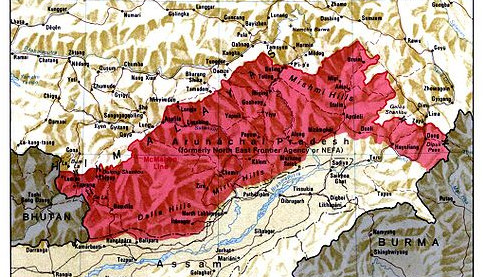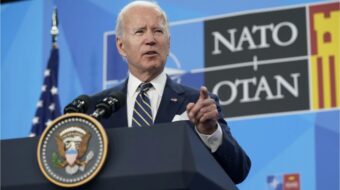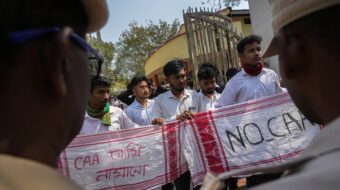
Of all the world’s potential hotspots, one of the most unlikely is tucked into the folds of the Himalayas. This slice of ground is little more than frozen rock fields and soaring peaks that is decidedly short on people, resources, and oxygen. But for the past year this border area has been a worrisome source of friction between India and China, including incursions by Chinese troops, the wounding of several Indian border police, and a buildup of military forces on both sides.
Some Indian analysts go so far as to say that China has now replaced Pakistan as India’s greatest threat. And indeed, Beijing has been uncharacteristically assertive in pushing its claims to a sizable chunk of India’s Arunachal Pradesh state.
Why the two huge Asian nations facing off over ground that all but the hardiest of goats avoid? The answer involves both colonialism’s bitter legacy and current U.S. efforts to maintain its pre-eminent role in the region.
Ghosts of ‘62
The area in question, which borders Tibet and covers an area about the size of Austria, is delineated by a boundary that has shifted over the millennia. The British drew the current line in 1914, but the Chinese have never recognized the agreement that established it -the so-called “Simja Convention” – because they saw it as just another treaty forced on China by Western colonial powers. Because the area in dispute was once connected to Tibet, Beijing says the region is part of China.
So far the tension on the border has resulted in little more than Chinese soldiers painting rocks red on the Indian side. In the one shooting incident, gunfire from the Chinese side of the border wounded two members of the Indo-Tibetan Police Force. The Indians have responded by moving 30,000 troops and its latest warplanes into the area.
The region has long been a volatile one. Similar tensions in 1962 sparked a 32-day war that killed 3,100 Indian and 700 Chinese soldiers, and resulted in a humiliating defeat for New Delhi.
India’s right wing, led by the Bharatija Janata Party (BJP), raised the specter of the 1962 war and is now demanding that India respond to Chinese “aggression.” “India must take adequate precautions,” says BJP President Rajnath Singh. Retired Indian Air Force Marshall Fali Homi says that China now poses a bigger threat than India’s traditional adversary, Pakistan, and former Indian National Security Advisor Brajesh Mishra predicts a China-India war within five years.
Some Indians even charge – without evidence – that China is supporting India’s homegrown Maoists, or Naxalites, who are waging a low-key insurgency against the Indian government.
The rhetoric on the Chinese side is less bombastic, but Beijing’s statements have been unusually sharp, especially after the Dalai Lama visited the region this past November.
China’s prickliness over its borders is hardly new. But with the exception of its attack on Vietnam in 1979, Beijing has threaded a careful path between asserting its power and reassuring its neighbors that it isn’t about to become the bully on the block. Why then the pugnacity over what can hardly be considered strategic ground?
Enter the United States
In 2005, the Bush administration executed a full court press to bring India into an alliance with Washington and its allies in the Pacific region – specifically Australia, South Korea, and Japan – to counter the rise of China. Washington warned that the Chinese military, in particular its naval arm, was expanding rapidly and would soon pose a threat to other nations in Asia. The United States and India held joint military operations, and the Washington urged New Delhi to actively patrol the Indian Ocean and the South China Sea.
Since 80 percent of China’s oil and gas supplies transit the Indian Ocean and South China Sea, talk of joint patrols was certain to draw a response from Beijing. And indeed, the Chinese navy is increasingly making its presence known in the area. China is also in the process of developing a series of friendly ports – its so-called “string of pearls” -from Africa to Southeast Asia.
The Bush administration also pushed through Congress the “1-2-3 Agreement,” which allows India to violate the Nuclear Non-Proliferation Treaty by buying uranium on the world market, even though New Delhi won’t sign the pact. This will allow India to rapidly increase its nuclear arsenal, which is certain to spark a similar buildup by Pakistan.
As Islamabad’s leading military supplier, China has long had a friendly relationship with Pakistan. It’s concerned that tension between India and Pakistan could lead to war. A recent study by climate scientists Alan Robock and Owen Toon found such a war would result in a “nuclear winter” that would devastate China, indeed, much of the world.
New Delhi and China are also at loggerheads over Afghanistan, with the Chinese dubious of the U.S. war and the Indians strongly supportive.
China’s response to the growing U.S.-Indian alliance was to oppose the “1-2-3 Agreement,” block India’s application for a permanent seat in the UN Security Council, and try to torpedo a loan from the Asian Development Bank to fund flood control in Arunachal Pradesh.
Growing Interdependence
Yet the current tensions between India and China over 90,000 thousand square miles of ice and rock fly in the face of a growing interdependence between the two Asian giants. China is now India’s number-one trading partner. Bilateral trade has risen from under $3 billion in 2000 to almost $52 billion in 2008, and is growing at almost three times the rate of U.S.-China trade. Estimates are that by 2020, China-India trade will surpass $410 billion, a figure equal to last year’s U.S.-China trade. China’s powerful manufacturing sector complements India’s wealth of raw materials and cutting-edge technology industry. China needs India’s iron ore, bauxite and manganese, and India needs China’s low-priced manufactured goods to upgrade its infrastructure. China also has huge foreign reserves to invest, although cross-border investment is still modest.
Both sides have tried to tamp down the border dispute. Asked about tensions between New Delhi and Beijing, India’s Deputy Foreign Minister Shashi Tharoor replied that “things seem to be very good,” adding that “minor irritants” had been blown our of proportion by the media.
And yet the region remains a witch’s brew of dangerous hotspots and powerful cross-currents: the U.S. escalation in Afghanistan, ongoing tension between India and Pakistan over Kashmir, and Washington’s sometimes warm, sometimes cool attitude toward China.
Indian newspapers have been filled with headlines like “Red Peril,” and “Enter the Dragon,” and senior Indian national security advisor M.K. Narayaman warned that “media hype” could set off an “unwarranted incident or accident.” Chinese newspapers and websites have also reflected strong nationalist sentiments over the issue.
If the Obama administration wants to avoid making a dangerous situation worse, it should revisit the “1-2-3 Agreement” and put the peaceful resolution of the Kashmir problem back on the table. During his presidential campaign, Obama promised to pressure both sides on Kashmir, the flashpoint for three wars between India and Pakistan. But under intense Indian pressure, Secretary of State Hillary Clinton and Special Envoy to South Asia Richard Holbrooke dropped the issue.
It’s also time for the United States to realize that it can no longer dominate Asia. In its efforts to maintain its former status as top dog in the region, Washington has exacerbated tensions among several countries in the area, tensions that have the potential to produce catastrophic consequences.
Image: Map of the disputed India-China border area. (commons.wikimedia.org)
Originally published at Foreign Policy in Focus under the headline “China, India Battle Over Thin Air,” and reposted with permission of the author.

MOST POPULAR TODAY

High Court essentially bans demonstrations, freedom of assembly in Deep South

Zionist organizations leading campaign to stop ceasefire resolutions in D.C. area

U.S. imperialism’s ‘ironclad’ support for Israel increases fascist danger at home

UN warns that Israel is still blocking humanitarian aid to Gaza







Comments